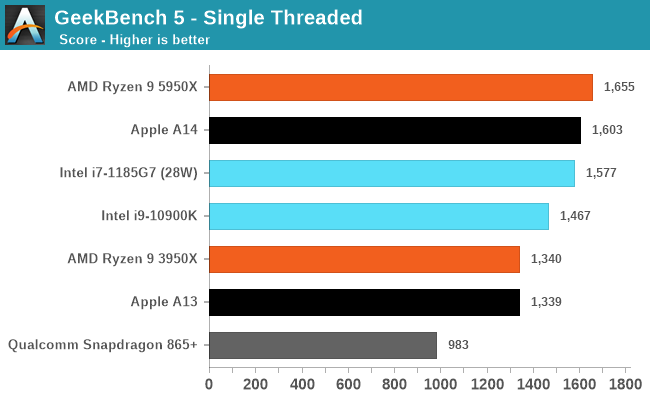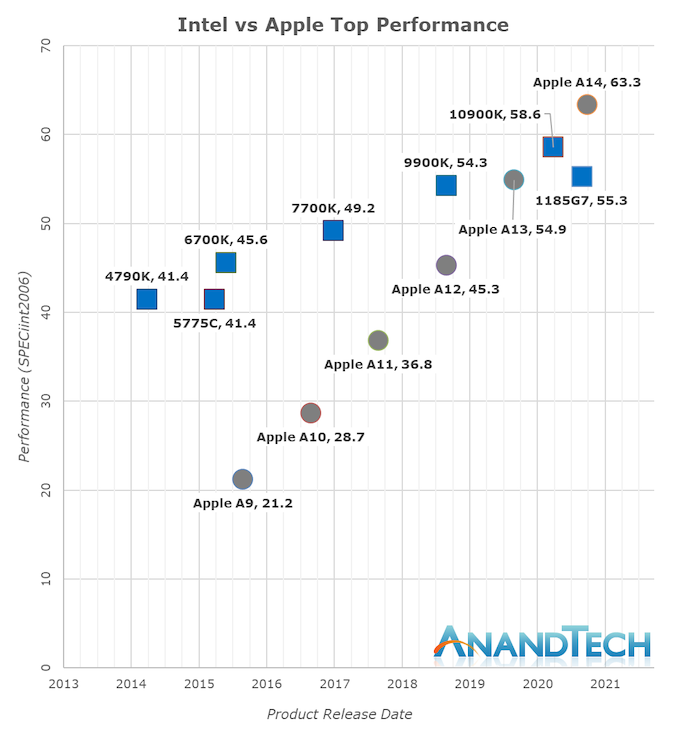Apple Announces The Apple Silicon M1: Ditching x86 - What to Expect, Based on A14
by Andrei Frumusanu on November 10, 2020 3:00 PM EST- Posted in
- Apple
- Apple A14
- Apple Silicon
- Apple M1
From Mobile to Mac: What to Expect?
To date, our performance comparisons for Apple’s chipsets have always been in the context of iPhone reviews, with the juxtaposition to x86 designs being a rather small footnote within the context of the articles. Today’s Apple Silicon launch event completely changes the narrative of what we portray in terms of performance, setting aside the typical apples vs oranges comparisons people usually argument with.
We currently do not have Apple Silicon devices and likely won’t get our hands on them for another few weeks, but we do have the A14, and expect the new Mac chips to be strongly based on the microarchitecture we’re seeing employed in the iPhone designs. Of course, we’re still comparing a phone chip versus a high-end laptop and even a high-end desktop chip, but given the performance numbers, that’s also exactly the point we’re trying to make here, setting the stage as the bare minimum of what Apple could achieve with their new Apple Silicon Mac chips.

The performance numbers of the A14 on this chart is relatively mind-boggling. If I were to release this data with the label of the A14 hidden, one would guess that the data-points came from some other x86 SKU from either AMD or Intel. The fact that the A14 currently competes with the very best top-performance designs that the x86 vendors have on the market today is just an astonishing feat.
Looking into the detailed scores, what again amazes me is the fact that the A14 not only keeps up, but actually beats both these competitors in memory-latency sensitive workloads such as 429.mcf and 471.omnetpp, even though they either have the same memory (i7-1185G7 with LPDDR4X-4266), or desktop-grade memory (5950X with DDR-3200).
Again, disregard the 456.hmmer score advantage of the A14, that’s majorly due to compiler discrepancies, subtract 33% for a more apt comparison figure.

Even in SPECfp which is even more dominated by memory heavy workloads, the A14 not only keeps up, but generally beats the Intel CPU design more often than not. AMD also wouldn’t be looking good if not for the recently released Zen3 design.

In the overall SPEC2006 chart, the A14 is performing absolutely fantastic, taking the lead in absolute performance only falling short of AMD’s recent Ryzen 5000 series.
The fact that Apple is able to achieve this in a total device power consumption of 5W including the SoC, DRAM, and regulators, versus +21W (1185G7) and 49W (5950X) package power figures, without DRAM or regulation, is absolutely mind-blowing.

There’s been a lot of criticism about more common benchmark suites such as GeekBench, but frankly I've found these concerns or arguments to be quite unfounded. The only factual differences between workloads in SPEC and workloads in GB5 is that the latter has less outlier tests which are memory-heavy, meaning it’s more of a CPU benchmark whereas SPEC has more tendency towards CPU+DRAM.
The fact that Apple does well in both workloads is evidence that they have an extremely well-balanced microarchitecture, and that Apple Silicon will be able to scale up to “desktop workloads” in terms of performance without much issue.
Where the Performance Trajectory Finally Intersects
During the release of the A7, people were pretty dismissive of the fact that Apple had called their microarchitecture a desktop-class design. People were also very dismissive of us calling the A11 and A12 reaching near desktop level performance figures a few years back, and today marks an important moment in time for the industry as Apple’s A14 now clearly is able to showcase performance that’s beyond the best that Intel can offer. It’s been a performance trajectory that’s been steadily executing and progressing for years:
Whilst in the past 5 years Intel has managed to increase their best single-thread performance by about 28%, Apple has managed to improve their designs by 198%, or 2.98x (let’s call it 3x) the performance of the Apple A9 of late 2015.
Apple’s performance trajectory and unquestioned execution over these years is what has made Apple Silicon a reality today. Anybody looking at the absurdness of that graph will realise that there simply was no other choice but for Apple to ditch Intel and x86 in favour of their own in-house microarchitecture – staying par for the course would have meant stagnation and worse consumer products.
Today’s announcements only covered Apple’s laptop-class Apple Silicon, whilst we don’t know the details at time of writing as to what Apple will be presenting, Apple’s enormous power efficiency advantage means that the new chip will be able to offer either vastly increased battery life, and/or, vastly increased performance, compared to the current Intel MacBook line-up.
Apple has claimed that they will completely transition their whole consumer line-up to Apple Silicon within two years, which is an indicator that we’ll be seeing a high-TDP many-core design to power a future Mac Pro. If the company is able to continue on their current performance trajectory, it will look extremely impressive.











644 Comments
View All Comments
SarahKerrigan - Tuesday, November 10, 2020 - link
Look at Anandtech's benchmarking in this very article. I'm sure you can find it if you look carefully.BlackHat - Tuesday, November 10, 2020 - link
Yes, I see the benchmarks, but that doesn't calm my concerns that if those numbers looks so good here why compare their chips against an SkyLake chip?michael2k - Tuesday, November 10, 2020 - link
Because they didn't pay Intel for any SkyLake chips?Essentially Intel's designs only improve by 10% per given generation, so given they've been stuck at 14nm and only have some 10nm parts, you might see a 10% or 15% improvement with the newest Intel parts.
A 10% or 15% improvement won't beat the M1
BlackHat - Tuesday, November 10, 2020 - link
What do you mean? Apple have Ice Lake MacBook that they could used to compare.valuearb - Tuesday, November 10, 2020 - link
Apple compared the M1 Macs vs. their exact predecessors, which is a 1.7 Ghz I7 in the case of the Mac Book Pro two port 13 inch.Note that the 13 inch Tiger Lake MBP had to be made thicker and heavier to accommodate Tiger Lake with adequate battery life.
Also that Anandtech's own benchmarks show Tiger Lake on par with the iPhone 12 A14 CPU, at four times the power usage.
name99 - Tuesday, November 10, 2020 - link
Give it a fscking rest. Go read Apple's web site:Testing conducted by Apple in October 2020 using preproduction MacBook Air systems with Apple M1 chip and 8-core GPU, as well as ***production 1.2GHz quad-core Intel Core i7-based MacBook Air systems***, all configured with 16GB RAM and 2TB SSD.
They tested against the currently shipping Mac equivalents. You want to test against your favorite laptop do it yourself, Apple doesn't owe you ever benchmark you can possibly imagine.
Apple tested against the competitor product as far as THEIR CUSTOMERS ARE CONCERNED. Everyone else in the world understands this, why can't you?
trixn86 - Wednesday, November 11, 2020 - link
Exactly this.They compared it to the competing device in their product line that most of their customers currently have in use. And those are also the customers that are most likely to consider to upgrade to a new device. Also 2.8x faster sounds better than 1.whatever x faster if they'd taken a best intel notebook cpu available whose users wouldn't want to upgrade anyways.Spunjji - Thursday, November 12, 2020 - link
Because it's like-for-like *within their product range*.Apple customers don't care about how fast it is when compared with somebody else's products.
Glaurung - Tuesday, November 10, 2020 - link
This article, that you seem to have not read, benchmarks the A14, in the latest iphone, against intel and AMD laptop/desktop chips.And the phone chip, with a 5w TDP, is as fast or faster than anything except the latest AMD desktop chip.
Given that there is no way the M1 is going to be *slower* than the chip in this years iphones, I think the article's conclusions are fair. And we'll have benchmarks of actual M1 macs to look at in another week or so.
BlackHat - Tuesday, November 10, 2020 - link
I'm just saying that if Apple didn't compare their chips against Ice Lake or even a more recent chip that give a lot of skepticism, Ice Lake is better than the Renoir in Spec but no so much in real word test, even those no multicore.